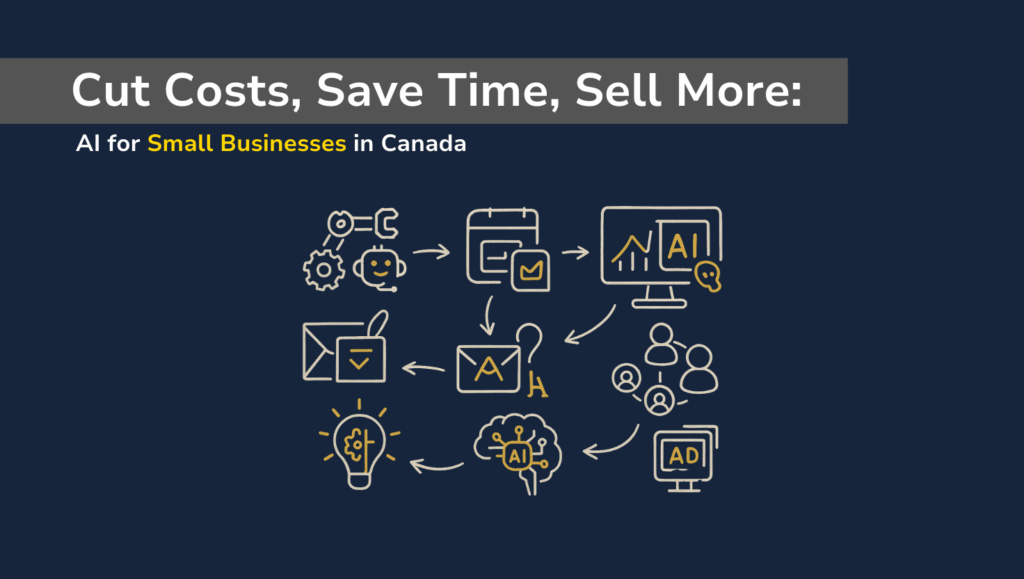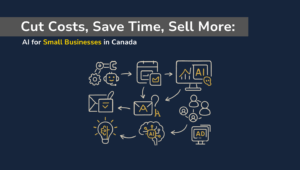For many small business owners in Canada, the term “Artificial Intelligence” might
conjure images of complex, expensive systems reserved for large corporations. You’re
already juggling countless tasks, from managing operations to attracting customers,
and the idea of integrating new, advanced technology can feel overwhelming. We
understand that hesitation. However, AI is no longer just for tech giants; it’s rapidly
becoming an accessible and powerful tool that can level the playing field, helping
Canadian SMEs boost efficiency, enhance customer experiences, and ultimately, drive
significant growth.
1. Streamline Operations with AI Automation
Time is your most valuable asset. AI tools can automate repetitive tasks, freeing you
and your team to focus on strategic initiatives and customer relationships.
Automated Customer Support: Implement AI-powered chatbots on your
website or social media to handle frequently asked questions, book
appointments, or provide instant support 24/7. This improves response times
and reduces staff workload.
Smart Scheduling & Management: Use AI-driven scheduling tools to optimize
appointments, manage staff rotas, and send automated reminders, minimizing
no-shows and maximizing productivity.
Data Entry & Reporting: AI can automate data extraction from documents,
categorize expenses, and generate financial reports, significantly reducing
manual administrative tasks and improving accuracy.
2. Enhance Customer Experience & Personalization
AI allows small businesses to offer personalized experiences that were once only
possible for large enterprises, fostering stronger customer loyalty.
Personalized Marketing: AI can analyze customer data to identify purchasing
patterns and preferences, enabling you to send highly targeted email campaigns,
product recommendations, and special offers.
Predictive Analytics: Use AI to forecast customer needs or identify potential
churn risks, allowing you to proactively engage with customers and offer
solutions before issues arise.
Sentiment Analysis: AI tools can analyze customer feedback from reviews, social
media, and support interactions to gauge sentiment, identify common pain
points, and improve service quality.
3. Optimize Marketing & Sales Efforts
AI can make your marketing budget work harder by identifying the most effective
strategies and personalizing outreach.
Content Creation & Curation: AI writing assistants can help generate blog post
ideas, social media captions, and email copy, saving time and ensuring
consistent messaging. AI can also curate relevant content for your audience.
Ad Optimization: AI-powered platforms can optimize your digital ad campaigns
(Google Ads, social media ads) by identifying the best performing keywords,
audiences, and ad creatives, maximizing your return on ad spend.
Lead Scoring: AI can analyze lead data to score prospects based on their
likelihood to convert, allowing your sales team to prioritize high-potential leads
and focus their efforts more effectively.
4. Gain Actionable Insights from Your Data
Even small businesses generate data. AI can transform this raw data into valuable
insights that drive better decision-making.
Sales Forecasting: AI can analyze historical sales data to predict future trends,
helping you manage inventory, staff levels, and marketing campaigns more
effectively.
Customer Segmentation: AI can identify distinct customer segments within your
client base, allowing for more tailored marketing messages and service offerings.
Operational Bottleneck Identification: AI can analyze operational data to
pinpoint inefficiencies or bottlenecks in your processes, suggesting areas for
improvement and cost savings.
Your AI for Small Business Action Plan:
1. Week 1-2: Identify Automation Opportunities: List 3-5 repetitive tasks in your
business (e.g., answering FAQs, scheduling, data entry). Research accessible AI
tools (e.g., ChatGPT, ManyChat, Zapier integrations) that can automate at least
one of these tasks.
2. Week 3-4: Enhance Customer Interaction: Implement a basic AI chatbot on
your website or Facebook page to handle common inquiries. Monitor its
performance and refine its responses.
3. Month 2: Smart Marketing Start: Experiment with an AI writing assistant for
generating social media posts or email subject lines. Analyze which AI-generated
content performs best.
4. Month 3: Data-Driven Decisions: If you use a CRM or POS system, explore its
built-in reporting features. Look for patterns or insights that AI could potentially
enhance in the future (e.g., identifying peak sales times, popular products).
5. Ongoing: Stay informed about new, accessible AI tools. Start small, experiment,
and scale up as you see tangible benefits. Focus on AI that solves a real business
problem or creates a clear advantage.









